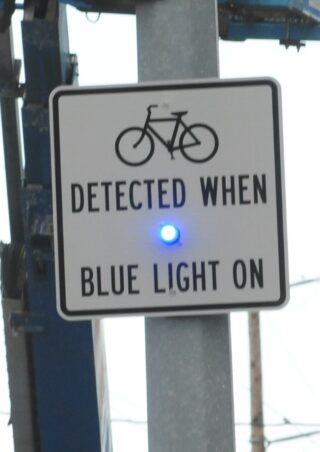
(Photos: J. Maus/BikePortland)
PBOT has been trying to educate bicycle riders how to get green lights for a long time now. I spotted their latest effort at a north Portland intersection earlier this week.
First they put little bicycle markings over the signal sensor. Then they added signs telling people to stop over the markings. Then they added a blue light that could detect your presence and offer assurance that your request had been submitted. And remember in 2016 when we teamed up with them to share your feedback about signal detection markings?
Why all the focus on this issue? Not only does it show basic respect to make signals compatible with all road users; but compliance goes way up when people know the signal is aware of them. When I was in Copenhagen and Amsterdam, I recall that nearly every intersection came with not only a bicycle signal, but a countdown timer telling you when it would turn green!
We’re not at that level yet, but PBOT still wants to do better.
While biking westbound on North Ainsworth at Interstate earlier this week I noticed the existing blue light is now surrounded by a sign. After posting the image to Twitter, Portland State University professor Chris Monsere said it was part of an ODOT-sponsored project he and his team are working on at the Transportation Research Education Consortium.
Advertisement
Here’s an excerpt from the summary:
“One of the key links in a bicycle network is signalized crossings of high volume and high speed roadways. At these intersections in Oregon, cyclists are primarily detected by inductive loops, often using the same inductive loops that are used for automobile detection. While vehicles are almost always detected automatically due to their size and predictable stopping location, that is not the case for bicycles. If a cyclist does not position themselves for detection there can be unnecessary delays. These delays lead to a lower quality experience and may lead to increased risk taking behavior (i.e. signal non-compliance). Improved detection for bicycles can be accomplished by proper loop placement, calibration of loop sensitivity, alternative detection technologies, or through the use of pavement markings that communicate the correct stopping location for bicyclists. The MUTCD 9C-7 bicycle stencil has been used to communicate where a person on a bicycle should position themselves. There has been interest in the adoption of bicycle feedback confirmation devices (examples include a blue light confirmation and “wait” countdown timers) to better communicate presence detection and delay to people on bicycles. Research is needed to evaluate the comprehension of these devices, to determine if additional signage is needed, and whether they influence the quality of the cycling experience.
An improvement to the quality of the cycling experience would be presence detection confirmation and/or a countdown timer. These devices are similar in purpose to the confirmation lights commonly used on pedestrian pushbuttons. When a cyclist is detected and the input recognized by the traffic signal controller, the confirmation device is activated. In the case of the countdown timer (used in some European countries), the timer counts down the time until the green display. Countdown timers for other modes (pedestrians and drivers) have been explored in the research literature.
It is hypothesized that confirmation feedback and countdown timers for cyclists might help reduce the level-of-stress for waiting cyclists. Given the relatively low cost of installation, they could be tools for creating infrastructure that promotes mobility, efficiency, and predictability for cyclists. There is limited research on the effect of the confirmation devices, accompanying informational signs, and countdown timers on the behavioral and psychological effects for bicyclists.”
Monsere’s project should be completed by March 2020. We’ll let you know how it goes and whether or not you can expect to see more of these in the future.
— Jonathan Maus: (503) 706-8804, @jonathan_maus on Twitter and jonathan@bikeportland.org
— Get our headlines delivered to your inbox.
— Support this independent community media outlet with a one-time contribution or monthly subscription.


